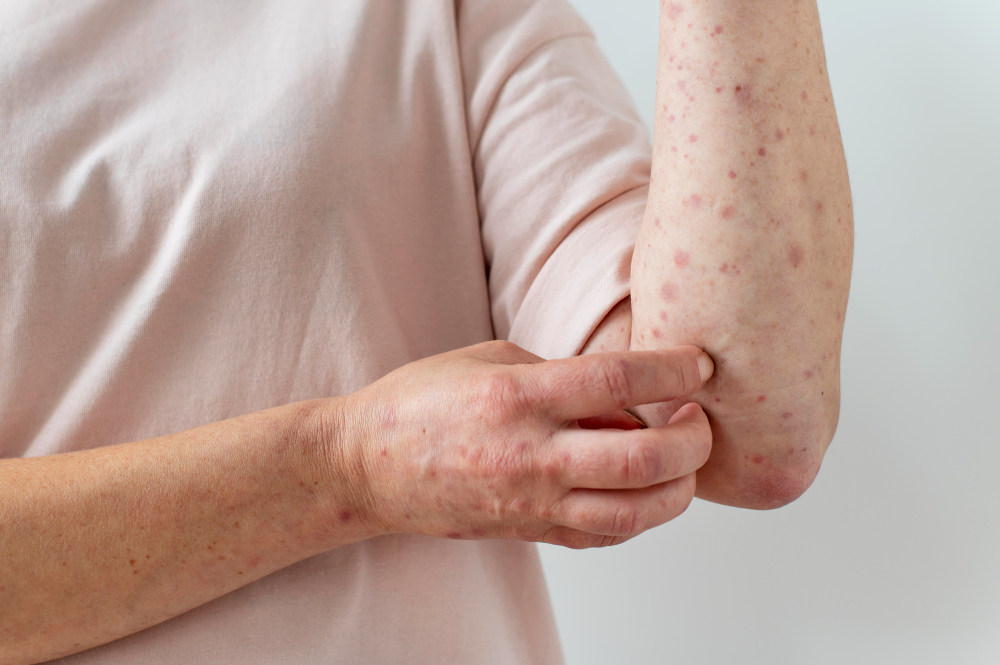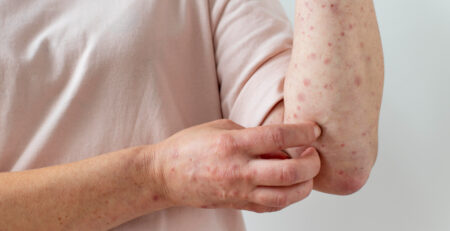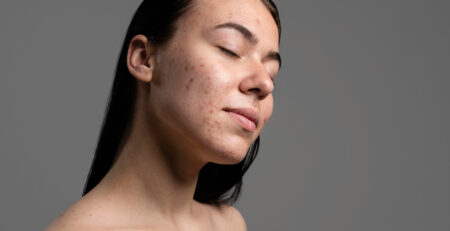Impetigo: Everything You Need to Know
Impetigo is a skin infection caused by bacteria that makes sores and blisters. It can look different in different parts of the body and at different stages of the infection.
What is impetigo?
Impetigo is a common skin infection that can spread easily. Bacteria like Staphylococcus aureus or Streptococcus pyogenes can get into the epidermis, which is the top layer of skin. Most people get it on their face, arms, and legs.
Anyone can get impetigo, but children, especially those between the ages of 2 and 5, are most likely to get it.
Most of the time, the infection starts in a small cut, an insect bites, or a rash like eczema, or anywhere else where the skin is broken. It can happen on healthy skin, too.
When it gets into healthy skin, it’s called primary impetigo. When it gets into broken skin, it’s called secondary impetigo. It’s not always easy or important to tell the difference.
Impetigo is a very old illness. The name comes from the Latin word impetere, which means “to attack.” It was first used in England in the 1400s.
Bacteria like it when it’s hot and damp. So, impetigo is most common in the summer and fall in northern climates, when the weather is hot and dry. It tends to happen all year long in places that are warm and humid.
A 2015 review found that about 162 million children around the world have impetigo at any given time. The review said that studies from Australia, New Zealand, and North America were not included because they were done on small, poorly-resourced populations that might not have been representative of the whole.
Impetigo is more common in poor areas of industrial countries and in developing countries. Oceania, which includes Australia, New Zealand, and several other countries, is one place where there are a lot of cases.
Impetigo symptoms
Red sores on the skin, usually around the nose and lips, are the first sign of impetigo. These sores quickly turn into blisters, ooze and burst, and then form a yellowish crust. The groups of blisters might get bigger and cover more skin. Sometimes the red spots just get a yellowish crust and don’t show any blisters.
The sores can sometimes itch and sometimes hurt. After the crust stage, they leave red marks that go away without scarring.
Infants can get a less common type of impetigo that causes larger blisters around the diaper area or in skin folds. Soon, these fluid-filled blisters will burst, leaving behind a collarette.
Impetigo can be uncomfortable. Sometimes, the area where the outbreak is happening may get a fever or swollen glands.
What causes impetigo?
Strains of the bacteria staphylococcus (staph) or streptococcus (strep) can cause impetigo. You can get these bacteria into your body if you have a cut, a scratch, an insect bite, or a rash. Then they can attack and take over.
The illness can spread to other people. You can get these bacteria if you touch a person’s sores or if you touch things that person used, like towels, clothes, or sheets.
But these bacteria are also common in our environment, and most people who come into contact with them won’t necessarily get impetigo.
Some people’s noses usually have staph bacteria on them. If the bacteria gets on their skin, they could get sick.
Both adults and kids are more likely to get impetigo if they:
- live in a warm, humid climate
- have diabetes
- have a compromised immune system, such as from HIV or AIDS
- have skin conditions, such as eczema, dermatitis, or psoriasis
- have a sunburn or other burns
- have itchy infections, such as lice, scabies, herpes simplex, or chickenpox
- have insect bites or poison ivy
- play contact sports
Who’s at risk of impetigo?
Even though anyone can get impetigo, the most common risk factor to get it is by being close to someone who already has it. Impetigo is more likely to spread when people are close together, such as:
- households
- schools
- day cares
- prisons
- military training facilities
Impetigo is also more likely to happen if you are older. Most kids between the ages of 2 and 5 are of the more common type, which is not bullying. The less common bullous type happens in 90 percent of children younger than 2 years old. When impetigo happens to adults, men are more likely to get it than women.
Cuts and scrapes can make you more likely to get impetigo. Be aware of activities that could hurt your skin, and if you can, wear the right gear or clothes to protect yourself. Wounds that are open should be washed and bandaged.
If you live in a hot or humid place, you are more likely to get impetigo, but it can happen anywhere.
If you poor personal hygiene well, you’re also more likely to get impetigo. You can lower your chances by:
- proper handwashing
- regular body washing
- keeping your face clean
Potential complications from impetigo
The bacteria that cause impetigo can also lead to other, more serious infections and bad immune reactions.
Staphylococcal scalded skin syndrome
Most 80 percent of the time, the bacteria Staphylococcus aureus is to blame for impetigo. Some toxins are released when this bacterium is present.
These toxins can cause impetigo in the area around an infection. If the toxins are spread around the body more, it can cause staphylococcal scalded skin syndrome (SSSS).
Soft tissue infection
The bacteria that cause impetigo can also cause other infections of the skin and soft tissues necrotizing fasciitis.
Toxic shock syndrome
toxic shock syndrome can be caused by the same bacteria that cause impetigo. When the bacteria leave the skin and get into the blood, a condition called toxic shock syndrome can happen. Most of the time, the symptoms show up quickly. It is a condition that could kill you and needs to be treated by a doctor.
MEDICAL EMERGENCY
The medical emergency is toxic shock syndrome. If you:
- fever
- low blood pressure
- decreased alertness or increased confusion
- vomiting
- fast breathing
- fast heart rate
Rheumatic fever
Group A is the first group. Streptococcus is a kind of bacteria that can cause strep throat and scarlet fever, and sometimes impetigo. If you get one of these infections, your immune system may respond with inflammation in the form of rheumatic fever.
Since rheumatic fever is a response by the immune system, it is not contagious. However, the infections that cause it can be.
Rheumatic fever most often happens to kids between the ages 5 to 15, but it can happen at any age. It needs to be taken care of right away to avoid long-term problems.
Diagnosing impetigo
If you think you have impetigo, you should see a doctor. Most of the time, they can tell what kind of infection it is by how it looks.
If the sores don’t heal, the doctor may want to grow the bacteria in a lab. This is done by taking a small amount of the liquid that comes out of the sore and testing it to see what kind of bacteria caused it. This helps figure out which antibiotics will work best against it.
Treatment of impetigo
Antibiotics are good at getting rid of impetigo. How many or bad the sores are will determine what kind of antibiotic you get.
If you only have impetigo on a small part of your skin, you should use antibiotics that you put on the skin. mupirocin cream or ointment (Bactroban or Centany) and retapamulin ointment are some of the choices (Altabax).
If you have severe or widespread impetigo, your doctor may give you oral antibiotics like:
- amoxicillin/clavulanate (Augmentin)
- certain cephalosporins
- clindamycin (Cleocin)
These drugs may work more quickly than topical antibiotics, but they aren’t necessarily better at clearing the infection.
Oral antibiotics can also cause more side effects, such as nausea, than topical antibiotics.
With treatment, impetigo usually heals in 7 to 10 days. If you have an underlying infection or skin disease, the infection may take longer to heal.
Impetigo on adults
Although impetigo is more common in young children, adults can get it too. Because it’s so contagious, impetigo can spread through any close contact. Adults who play sports often catch it from skin-to-skin contact.
The symptoms of impetigo in adults are sores around the nose and mouth or other exposed areas of the body. These sores break open, ooze, and then crust.
Generally, impetigo is a mild skin condition, but adults have a higher risk of complications than children. These complications may include:
- acute post-streptococcal glomerulonephritis (which most commonly
- Trusted Source
- affects children and older adults)
- cellulitis
- lymphangitis
- sepsis
Adults can get other contagious rashes besides impetigo. Here are some more contagious skin conditions.
Impetigo on toddlers
Toddlers are the most likely age group to develop impetigo. The infection looks different on young children than it does on adults. Parents may see sores on their child’s:
- nose and mouth area
- trunk (torso)
- hands
- feet
- diaper area
Most of the time, it’s because the child is scratching an insect bite or cut on their skin. When you scratch, bacteria can get into the skin.
If you keep scratching, you could get a bigger infection or scars.
Parents can help avoid problems by covering their child’s wounds and cutting their nails.
Stages of impetigo by type
There are three kinds of impetigo based on the bacteria that cause them and the sores that form. Each type has a set of stages that it goes through.
Nonbullous
Staphylococcus aureus is the main cause of nonbullous impetigo. A 2014 review found that it is the most common type of impetigo, causing about 70 percent of cases.
The following steps are involved:
- Most of the time, it starts with sores around the mouth and nose that are red and itchy.
- When the sores open up, the skin around them gets red and itchy.
- A yellow-brown crust forms.
- When the crusts fall off, there are red spots that fade and don’t leave scars.
Bullous
Most of the time, Staphylococcus aureus bacteria are to blame for bullous impetigo.
It usually forms larger blisters, or bullae, filled with a clear fluid that may become darker and cloudy. The blisters start on skin that is not broken, and there are no red spots around them.
The blisters get clear and soft, and then they pop.
The place where the blisters broke open turns yellow and crusty.
The blisters usually leave no scars behind when they heal.
Ecthyma
This infection is much less common and much more dangerous. When impetigo isn’t treated, it sometimes happens. Ecthyma is the worst kind of impetigo because it goes deeper into the skin and hurts more.
- The infection forms painful blisters on the skin of the buttocks, thighs, legs, ankles, and feet.
- The blisters change into sores that are filled with pus and have a thicker crust.
- The skin around the wounds often turns red.
- Ecthyma sores take a long time to heal, and they may leave scars when they do.
Home treatment options for impetigo
The main way to treat impetigo is with antibiotics, but you may be able to speed up the healing process with home treatments in addition to what your doctor tells you to do.
Warm water and OTC antibiotics
Clean the sores and soak them three or four times a day until they heal. Use warm water and soap to clean the sores gently, and then peel off the crusts. If you don’t wash your hands well after treating the sores, the infection could spread.
Dry the area and put on the antibiotic ointment as directed by your doctor. Then, if you can, lightly cover the sores with gauze if they are in a place where you can.
For a small outbreak, you can use an over-the-counter (OTC) antibiotic ointment that you can buy at the store. After you clean the area, use it three times a day. Then, put a bandage or gauze over the wound. If you don’t feel better after a few days, you should see a doctor.
Household bleach
A 15-minute bath with a very weak solution of bleach is another home treatment (2.2 percent). If you use this often, it will cut down on the number of bacteria on your skin.
Use 1/2 cup of bleach for a full-size bath. Wash it off with warm water and then pat it dry.
Use caution if you have sensitive skin. Some people get sick when they touch bleach. Also, you need to keep an eye on bathwater, bleach, and other home remedies to keep kids from drowning or eating them by accident.
Other remedies
There are also a lot of home remedies you can buy at a drugstore or natural products store. If you Using them correctly, they might help your impetigo, but they haven’t been shown to treat impetigo on their own.
Essential oils for impetigo
Essential oils are liquids extracted from plants. There are dozens of essential oils that kill bacteria. This suggests that essential oils might be a good way to treat impetigo, but there isn’t any research to back this up yet.
Some of the bacteria that cause impetigo have become resistant to antibiotics, which means that these products might be better than antibiotics.
Some essential oils that can be used to treat impetigo are:
- geranium oil
- patchouli oil
- tea tree oil
Talk to a doctor before you try any essential oil or other alternative treatment. Some of these products can have side effects, and they may not be safe for everyone. Before you put essential oil on your skin, make sure to mix it with a carrier oil. Don’t put it in your eyes or near them.
A note on effectiveness of essential oils
Research shows that essential oils may be good for your health, but the FDA doesn’t check or regulate their purity or quality. Before you start using essential oils, you should talk to a doctor or nurse and look into the quality of the products from each brand. Before you try a new essential oil, you should always do apatch test.
Preventing impetigo
If the sores can’t be covered reliably, kids with impetigo should stay home until the infection is no longer active and can’t be spread to others. Adults who have jobs that require them to be close to other people should ask their doctor when it’s safe for them to go back to work.
The best way to avoid impetigo is to take care of your hygiene. Here are some tips:
- To cut down on skin bacteria, take baths and wash your hands often.
- Cover any cuts or bug bites to keep the area safe.
- Keep your fingernails clean and trimmed.
- Don’t scratch or touch open wounds. This can make the sickness spread.
- Everything that touches the impetigo sores should be washed in hot water and laundry bleach.
- Change bed sheets, towels, and clothes that come in contact with the sores often until the sores are no longer contagious.
- Surfaces, tools, and toys that may have come in contact with impetigo should be cleaned and disinfected.
- If someone has impetigo, don’t let them borrow any of your things.
Is impetigo contagious?
The open sores are very likely to spread disease. If you scratch the sores, the infection can spread to other parts of your skin or to another person. The infection can also spread when a person with impetigo touches something else.
Impetigo is sometimes called the school disease because it is so easy to spread. It can spread quickly from one child to another in a classroom or day care where kids are close together. It’s easy to spread in families for the same reason.
Hygiene is the key to stopping the spread of impetigo. If you or your child has impetigo, you should wash and disinfect anything the infection could touch, such as:
- clothes
- bedding
- towels
- toys
- sports equipment
Topical antibiotics like mupirocin can usually get rid of impetigo in a few days and make it less contagious for a shorter amount of time. After 24 to 48 hours of taking antibiotics by mouth, the infection will no longer spread.
Impetigo vs. cold sore
Cold sores are blisters that form around your mouth, just like impetigo. They could also be on your nose or fingers.
The herpes simplex virus is what causes cold sores herpes simplex virus (HSV). There are two kinds of this virus: HSV-1 and HSV-2. Cold sores are usually caused by HSV-1, while genital herpes is caused by HSV-2.
Cold sores can be treated with creams and pills that kill the virus. Cold sores are caused by a virus that can be spread or caught through kissing. Cold sores are contagious until they form a crust, so don’t kiss anyone who has never had a cold sore until the crust forms.
Cold sores develop in five steps. Find out what to expect when you see one.
Impetigo vs. ringworm
Ringworm is a skin infection caused by fungi. The name comes from the way the red, raised skin patches look like rings. Ringworm doesn’t make yellow crusts like impetigo does.
You can get ringworm by coming into direct contact with someone who has it or by sharing items with someone who does. The ring may show up on:
- scalp
- body
- skin around the groin (called jock itch)
- feet (called athlete’s foot)
Most of the time, an antifungal skin cream is used to treat it. Some things can be bought without a prescription. Others must be given by a doctor on a prescription.
Ringworm can make you feel itchy and irritated. Good hygiene can help stop it from happening or stop it from happening again.
Impetigo vs. erysipelas
Erysipelas is a skin infection caused by bacteria that affects the top layers of skin. Strep bacteria, the same ones that cause strep throat, are to blame. Like impetigo, these bacteria get into the skin through a cut or crack, just like impetigo.
People with erysipelas get blisters on their legs and faces. Some other signs are a fever and chills.
Most of the time, antibiotics are given by mouth to treat the infection. In more serious cases, antibiotics may need to be given through an intravenous (IV) in a hospital.
Most of the time, treatment is very effective at getting rid of the infection. If you don’t treat erysipelas, you may be more likely to get serious complications.
Impetigo vs. eczema
Eczema not a virus or bacteria. Instead, it could be a reaction to something in your environment, like detergent, metal, or latex, or it could be linked to allergies or asthma.
Some of the signs of eczema are:
- red, itchy skin
- dry skin
One kind, called dyshidrotic eczema, makes small blisters on your hands or feet that are filled with fluid. Sometimes these blisters itch or hurt.
Eczema is more likely to happen to people who have allergies. If you stay away from the thing that caused the skin reaction, it won’t happen again.
Takeaway
Impetigo is a skin infection caused by bacteria that spreads quickly and is usually not serious. Antibiotics help it get better faster, and good hygiene is important to stop it from spreading.
If you think you or someone you care about has impetigo, you should see a doctor.







Leave a Reply